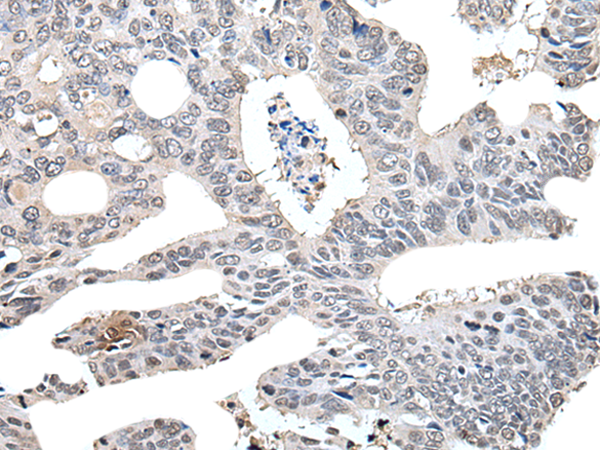
| WB | 咨询技术 | Human,Mouse,Rat |
| IF | 咨询技术 | Human,Mouse,Rat |
| IHC | 1/30-1/150 | Human,Mouse,Rat |
| ICC | 技术咨询 | Human,Mouse,Rat |
| FCM | 咨询技术 | Human,Mouse,Rat |
| Elisa | 1/5000-1/10000 | Human,Mouse,Rat |
| Aliases | SIII; TCEB2 |
| Host/Isotype | Rabbit IgG |
| Antibody Type | Primary antibody |
| Storage | Store at 4°C short term. Aliquot and store at -20°C long term. Avoid freeze/thaw cycles. |
| Species Reactivity | Human, Mouse, Rat |
| Immunogen | Fusion protein of human ELOB |
| Formulation | Purified antibody in PBS with 0.05% sodium azide and 50% glycerol. |
+ +
以下是关于ELOB抗体的3篇参考文献的简要信息:
1. **文献名称**:Elongin BC complex regulates autophagy and cancer cell survival through mTORC1 signaling
**作者**:Kamura T, et al.
**摘要**:研究揭示了ELOB/ELOC复合物通过调控mTORC1信号通路影响自噬和癌细胞存活,实验中利用ELOB抗体进行免疫共沉淀验证复合物相互作用。
2. **文献名称**:Structural basis of VHL-mediated transcription elongation by the Elongin BC complex
**作者**:Muniz JRC, et al.
**摘要**:通过冷冻电镜解析ELOB/ELOC复合物的结构,阐明其调控RNA聚合酶II的分子机制,研究中使用ELOB抗体进行蛋白质印迹验证表达水平。
3. **文献名称**:Elongin B and C interaction regulates DNA damage response in glioblastoma
**作者**:Li Y, et al.
**摘要**:报道ELOB/ELOC复合物在胶质母细胞瘤DNA损伤应答中的作用,通过ELOB抗体的免疫荧光实验证实其在细胞核内的定位变化。
ELOB (Elongin B) is a critical subunit of the Elongin complex, which plays dual roles in transcriptional regulation and protein ubiquitination. The Elongin complex consists of Elongin A (a transcription elongation factor), Elongin B, and Elongin C. Structurally, ELOB and ELOC form a stable heterodimer that interacts with Elongin A to enhance RNA polymerase II processivity during transcription. Additionally, ELOB/ELOC serves as a core component of the von Hippel-Lindau (VHL) tumor suppressor complex, which functions as an E3 ubiquitin ligase targeting hypoxia-inducible factor (HIF-1α) for proteasomal degradation.
ELOB antibodies are widely used to study these molecular mechanisms, particularly in cancer research. Dysregulation of ELOB-containing complexes is linked to tumorigenesis, as seen in VHL syndrome where mutations disrupt HIF-1α degradation, promoting angiogenesis and tumor growth. Researchers employ ELOB antibodies in techniques like Western blotting, immunoprecipitation, and immunohistochemistry to analyze protein expression, complex formation, and subcellular localization. These tools help elucidate ELOB's role in cellular responses to hypoxia, DNA repair, and its interplay with oncogenic pathways.
The specificity and reliability of ELOB antibodies make them essential for investigating transcriptional elongation, ubiquitination pathways, and therapeutic targets in diseases like renal cell carcinoma. Their application continues to advance understanding of ELOB's regulatory functions in both normal physiology and pathology.
×